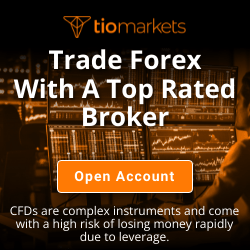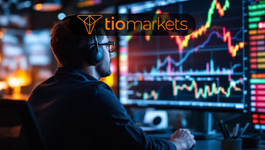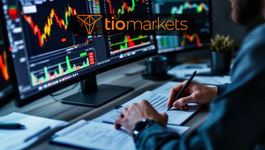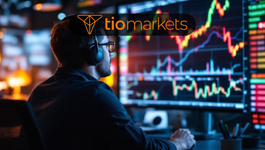ETFs Explained: What They Are and How to Trade Them | TIOmarkets
BY TIOmarkets
|junio 7, 2024Exchange-Traded Funds (ETFs) have emerged as one of the most popular investment vehicles for both novice and experienced investors. This article aims to demystify ETFs, explaining their nature, benefits, and how they can be traded. Whether you're looking to diversify your portfolio or seeking an entry point into the financial markets, understanding ETFs is a crucial step.
What Are ETFs?
At their core, ETFs are investment funds traded on stock exchanges, much like individual stocks. They are designed to track the performance of a particular index, commodity, bonds, or a mixture of investment types. This unique structure offers investors a straightforward way to gain exposure to a wide array of assets.
Types of ETFs
ETFs come in various forms, each catering to different investor needs and market sectors. Broadly, they can be classified into several categories:
- Equity ETFs: These funds invest in stocks and aim to replicate the performance of a specific stock index.
- Bond ETFs: Focused on investments in government or corporate bonds, offering a more stable income.
- Commodity ETFs: These ETFs invest in physical commodities like gold or oil.
- Sector and Industry ETFs: Target specific sectors, such as technology, healthcare, or finance.
- International ETFs: Offer exposure to foreign markets.
How ETFs Work
ETFs pool money from many investors to purchase a portfolio of assets. When you buy an ETF share, you're buying a piece of this portfolio, mirroring the performance of the underlying assets. ETFs are known for their liquidity, as they can be bought and sold throughout the trading day at market price.
Benefits of Trading ETFs
ETFs offer a compelling mix of advantages that cater to a wide range of investment strategies. Here are some of the key benefits:
Diversification
One of the primary advantages of ETFs is the ability to diversify your portfolio through a single transaction. By investing in an ETF, you gain exposure to the basket of assets it holds, reducing the risk associated with individual investments.
Cost-Effectiveness
ETFs typically have lower expense ratios compared to mutual funds. Additionally, the ability to trade ETFs like stocks helps investors save on brokerage fees and avoid the minimum investment requirements often associated with mutual funds.
Flexibility and Liquidity
ETFs are traded on stock exchanges, which means they can be bought and sold throughout the trading day at current market prices. This flexibility allows investors to react quickly to market changes.
Transparency
Most ETFs regularly disclose their holdings, providing investors with a clear understanding of where their money is invested.
How to Trade ETFs
Trading ETFs is similar to trading any other type of stock. Here's a simplified guide to get you started:
Opening a Brokerage Account
The first step is to open an account with a brokerage that offers ETF trading. TIOmarkets, for example, provides access to a wide range of ETFs across different sectors and geographies.
Research and Select ETFs
Before investing, it's crucial to research and select ETFs that align with your investment goals and risk tolerance. Consider factors such as the ETF's performance history, expense ratio, and the sectors or assets it covers.
Place Your Order
Once you've selected an ETF, you can place an order through your brokerage's trading platform. You'll need to decide on the order type (e.g., market order, limit order) and the number of shares you wish to purchase.
Monitor Your Investment
After purchasing ETF shares, it's important to monitor your investment and stay informed about market developments. This will help you make informed decisions about when to buy more shares, hold your position, or sell.
Risks of Trading ETFs
While ETFs offer numerous benefits, they also come with their own set of risks:
Market Risk
Like any investment, ETFs are subject to market risk. The value of an ETF can decrease due to movements in the underlying assets or market sectors it represents.
Liquidity Risk
Some ETFs, especially those tracking niche markets or sectors, may have lower trading volumes, which can lead to liquidity risk. This might make it harder to buy or sell shares at desired prices.
Tracking Error
Tracking error refers to the discrepancy between the performance of an ETF and its underlying index. This can occur due to various factors, including transaction costs and management fees.
In conclusion, ETFs offer a versatile and efficient way to invest in a wide range of assets. By understanding the basics of what ETFs are, their benefits, and how to trade them, investors can leverage these instruments to achieve their investment objectives. However, like all investments, it's important to conduct thorough research and consider the risks involved.
ETFs vs. Mutual Funds
When considering investment options, investors often compare ETFs to mutual funds. While both have their advantages, there are key differences between the two:
Trading Flexibility
ETFs trade on exchanges throughout the day, allowing investors to buy and sell at market prices. In contrast, mutual funds are priced at the end of the trading day, based on the net asset value (NAV).
Expense Ratios
ETFs generally have lower expense ratios compared to mutual funds. This cost efficiency can lead to higher returns for ETF investors over time.
Minimum Investment
Many mutual funds have minimum investment requirements, which can be a barrier for some investors. ETFs, on the other hand, can be purchased for the price of a single share plus any associated brokerage fees.
Tax Efficiency
ETFs are known for their tax efficiency, as they typically have lower capital gains distributions compared to mutual funds. This can result in lower tax liabilities for ETF investors.
ETFs and Market Volatility
Market volatility can impact all types of investments, including ETFs. During periods of high volatility, ETF prices may experience greater fluctuations, presenting both risks and opportunities for investors.
Hedging Strategies
Some investors use ETFs as part of their hedging strategies during volatile market conditions. By investing in ETFs that track inverse or leveraged indexes, investors can potentially offset losses in other parts of their portfolio.
Opportunistic Trading
For active traders, market volatility can create opportunities to profit from short-term price movements in ETFs. However, it's essential to have a solid understanding of market dynamics and risk management strategies when engaging in opportunistic trading.
Long-Term Perspective
Despite short-term fluctuations, many investors view ETFs as long-term investment vehicles. By diversifying across asset classes and sectors, ETF investors aim to weather market volatility and achieve their financial goals over time.
Choosing the Right ETFs
With a vast array of ETFs available in the market, selecting the right ones for your portfolio can be a daunting task. Here are some factors to consider when choosing ETFs:
Investment Objectives
Define your investment goals and risk tolerance before selecting ETFs. Whether you're seeking growth, income, or capital preservation, there are ETFs tailored to various objectives.
Expense Ratios and Fees
Compare the expense ratios and fees of different ETFs, as these costs can impact your overall returns. Look for ETFs with competitive expense ratios and transparent fee structures.
Asset Class and Sector Exposure
Consider the asset classes and sectors you want exposure to in your portfolio. Whether you're interested in equities, fixed income, commodities, or specific industries, there are ETFs available to match your preferences.
Historical Performance
While past performance is not indicative of future results, analyzing the historical performance of an ETF can provide insights into its volatility and return potential. Look for ETFs with consistent performance relative to their benchmarks.
Tracking Methodology
Understand how an ETF tracks its underlying index or asset. Whether it uses physical replication, synthetic replication, or a sampling strategy can impact the ETF's performance and tracking error.
ETFs and Environmental, Social, and Governance (ESG) Investing
Environmental, Social, and Governance (ESG) investing has gained traction in recent years, with investors increasingly considering sustainability factors in their investment decisions. ETFs have responded to this trend by offering ESG-focused funds that align with investors' values.
ESG Criteria
ESG ETFs screen companies based on environmental, social, and governance criteria. This screening process aims to include companies with strong sustainability practices and responsible business conduct in the ETF's portfolio.
Impact Investing
Investors looking to make a positive impact through their investments can consider ESG ETFs focused on specific themes, such as clean energy, gender diversity, or water conservation. These ETFs allow investors to align their financial goals with their values.
Performance Considerations
While ESG ETFs prioritize sustainability, investors should also assess the financial performance of these funds. Analyzing the ESG criteria, sector allocations, and historical returns can help investors make informed decisions about incorporating ESG ETFs into their portfolios.
By incorporating ESG factors into their investment strategies, investors can contribute to sustainable practices while potentially achieving competitive returns.
ETFs and Tax Considerations
When investing in ETFs, it's essential to understand the tax implications associated with these investment vehicles. Here are some key tax considerations for ETF investors:
Capital Gains Taxes
ETF investors may be subject to capital gains taxes when selling their ETF shares at a profit. The tax rate on capital gains depends on the holding period of the ETF shares.
Dividend Taxes
ETFs that distribute dividends to investors may be subject to dividend taxes. The tax treatment of dividends can vary based on factors such as the type of dividends received and the investor's tax bracket.
Creation and Redemption Process
ETFs use an in-kind creation and redemption process, which can help minimize capital gains distributions. This tax-efficient structure benefits investors by reducing the tax impact of portfolio turnover within the ETF.
Tax-Loss Harvesting
ETF investors can utilize tax-loss harvesting strategies to offset capital gains with capital losses. By selling underperforming ETFs at a loss, investors can reduce their tax liabilities on capital gains.
Qualified Dividend Income
Some ETF dividends may qualify for lower tax rates known as qualified dividend income. Investors should be aware of the tax treatment of ETF dividends and how it may impact their overall tax obligations.
ETFs and Portfolio Construction
ETFs play a crucial role in portfolio construction, offering investors a diverse range of investment options to build well-balanced portfolios. Here are some considerations for incorporating ETFs into your investment strategy:
Asset Allocation
ETFs provide exposure to various asset classes, allowing investors to diversify their portfolios across equities, fixed income, commodities, and other investment categories. By strategically allocating assets through ETFs, investors can manage risk and pursue their financial goals.
Risk Management
ETFs can be used to implement risk management strategies within a portfolio. By investing in ETFs with low correlations to existing holdings, investors can reduce overall portfolio risk and enhance diversification.
Sector Rotation
Some investors use sector-specific ETFs for tactical asset allocation and sector rotation strategies. By monitoring economic trends and sector performance, investors can capitalize on opportunities in specific industries through ETF investments.
Income Generation
Income-focused investors can utilize dividend ETFs and fixed income ETFs to generate regular income streams within their portfolios. These ETFs provide exposure to high-dividend stocks or bond portfolios, offering income stability and potential growth.
Rebalancing Strategies
ETFs facilitate portfolio rebalancing by allowing investors to adjust their asset allocations efficiently. By periodically rebalancing a portfolio using ETFs, investors can maintain their desired risk-return profile and adapt to changing market conditions.
ETFs and Investment Strategies
ETFs can be integrated into various investment strategies to achieve specific financial objectives. Whether you're a passive investor seeking broad market exposure or an active trader implementing tactical strategies, ETFs offer versatility and efficiency in portfolio management.
Passive Investing
Passive investors often use ETFs to gain exposure to broad market indexes or specific asset classes. By holding a diversified portfolio of ETFs, passive investors can achieve market returns while minimizing individual stock risk.
Factor Investing
Factor-based ETFs target specific investment factors such as value, growth, momentum, or quality. Investors can use factor ETFs to tilt their portfolios towards factors that historically outperform the market, based on their investment preferences.
Asset Allocation
ETFs are instrumental in asset allocation strategies, allowing investors to allocate capital across different asset classes based on their risk tolerance and investment horizon. By combining ETFs with varying risk profiles, investors can create well-balanced portfolios tailored to their financial goals.
Trading Strategies
Active traders leverage ETFs for short-term trading strategies, taking advantage of intraday price movements and market trends. ETFs with high liquidity and sector-specific focus are popular among traders looking to capitalize on short-term opportunities.
Risk Management
ETFs play a vital role in risk management strategies, enabling investors to hedge against market downturns or sector-specific risks. By incorporating inverse or leveraged ETFs into their portfolios, investors can protect against downside risk and enhance portfolio stability.
ETFs and Market Trends
As the financial markets evolve, ETFs continue to adapt to emerging trends and investor preferences. Understanding current market trends can help investors identify opportunities and make informed decisions when selecting ETFs for their portfolios.
Thematic Investing
Thematic ETFs focus on specific investment themes or trends, such as technology innovation, clean energy, or healthcare advancements. These ETFs allow investors to capitalize on emerging trends and industries poised for growth.
Sustainable Investing
With increasing emphasis on sustainability and corporate responsibility, ESG ETFs have gained popularity among investors seeking to align their investments with environmental and social values. Sustainable investing trends are driving the growth of ESG-focused ETFs in the market.
Smart Beta Strategies
Smart beta ETFs combine elements of passive indexing with active stock selection based on specific factors or investment criteria. These ETFs aim to outperform traditional market-cap-weighted indexes by targeting factors like low volatility, high dividends, or earnings growth.
Global Market Exposure
ETFs offering exposure to global markets have become increasingly popular as investors seek diversification beyond domestic equities. Global ETFs provide access to international markets, allowing investors to capitalize on global economic growth and market opportunities.
Digital Assets and Cryptocurrencies
The rise of digital assets and cryptocurrencies has led to the emergence of ETFs tracking blockchain technology, cryptocurrency indexes, and digital asset portfolios. These ETFs cater to investors interested in the potential of blockchain innovation and the cryptocurrency market.
Conclusion
ETFs have revolutionized the investment landscape, offering investors a versatile and efficient way to access a diverse range of assets and investment strategies. By understanding the fundamentals of ETFs, their benefits, risks, and various applications in portfolio management, investors can make informed decisions to achieve their financial goals. Whether you're a passive investor seeking broad market exposure or an active trader implementing tactical strategies, ETFs provide a flexible and cost-effective tool to navigate the complexities of the financial markets.
Start Trading ETFs with TIOmarkets
Now that you're equipped with the knowledge of ETFs and their trading potential, it's time to put theory into practice. Join the 170,000+ traders who have already chosen TIOmarkets as their gateway to the financial markets. With our top-rated forex broker platform, you can trade over 300 instruments across 5 markets, including Forex, indices, stocks, commodities, and futures, all with low fees. Enhance your trading skills with our comprehensive educational resources and step-by-step guides. Ready to dive into the world of ETF trading? Create a Trading Account today and start your journey towards financial success.

Risk disclaimer: CFDs are complex instruments and come with a high risk of losing money rapidly due to leverage. You should consider whether you understand how CFDs work and whether you can afford to take the high risk of losing your money. Never deposit more than you are prepared to lose. Professional client’s losses can exceed their deposit. Please see our risk warning policy and seek independent professional advice if you do not fully understand. This information is not directed or intended for distribution to or use by residents of certain countries/jurisdictions including, but not limited to, USA & OFAC. The Company holds the right to alter the aforementioned list of countries at its own discretion.
Join us on social media

Behind every blog post lies the combined experience of the people working at TIOmarkets. We are a team of dedicated industry professionals and financial markets enthusiasts committed to providing you with trading education and financial markets commentary. Our goal is to help empower you with the knowledge you need to trade in the markets effectively.
Related Posts





